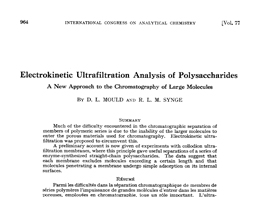
Although the monolithic stationary phases suitable for separations were introduced in the 1990s [1,2,3], the idea of using a “continuous block of the porous gel structure” as stationary phase was discussed in Analyst by R. L. M. Synge, A. J. P. Martin, and A. Tiselius as longs ago as in 1952.
Both equilibrium and kinetic aspects of the molecular-sieve properties of zeolites have been studied in detail by Barrer, and it is clear that these equilibria could be used for the separation of small molecules on chromatographic columns of zeolites. Zeolites could not be used with larger molecules, as the spaces in them are too small. However, from dialysis and ultrafiltration studies enough is known of the properties of membranes and gel structures to suggest that these, though their pores could not be expected to possess the regularity of those of zeolites, could nevertheless be used for more refined separations than have hitherto proved possible. If used as powders in ordinary chromatograms, however, these substances would exhibit the disadvantages already discussed, namely that adsorption, increasing with molecular weight, would work in the opposite sense to molecular-sieve effects. An alternative possibility, suggested in discussions between Dr. A. J. P. Martin, Prof. A. Tiselius and one of us (R.L.M.S.), is to use electro-endosmosis to move a solution through a continuous block of porous gel structure. In this way the equivalent of movement of liquid through a very thick ultrafiltration membrane is attained without the necessity of great hydrostatic pressures, which would destroy the membrane structure. Here adsorption and molecular-sieve or frictional effects would all act in the same sense, tending to retard more the larger molecules.
And conclusions?
- Smart people have smart ideas.
- Each idea we are reading today in scientific journals may have a huge impact in comming years. At least in same way, as monoliths have changed the chromatography.